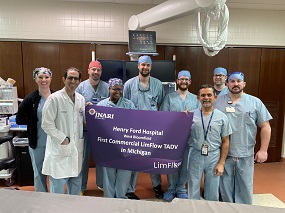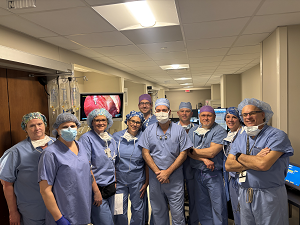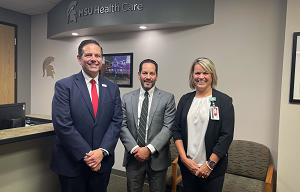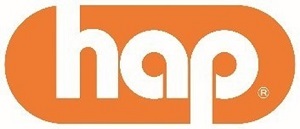Henry Ford Health Performs First Commercial “LimFlow” Patient Procedure in Michigan

DETROIT (March 21, 2024) – The first commercial procedure on a patient in Michigan using the LimFlow System was performed earlier this month by vascular and endovascular surgeon Tamer Boules, M.D., Section Chief and Director of Vascular Services at Henry Ford West Bloomfield Hospital, assisted by vascular surgeon Ajith Kadakol, M.D.
The LimFlow System for Transcatheter Arterialization of Deep Veins (TADV) approved by the Food & Drug Administration last fall is a last hope for people afflicted with severe vascular disease and forms of Chronic Limb-Threatening Ischemia (CLTI), or insufficient arterial blood flow, of the lower limbs, that can lead to complications such as severe pain, gangrene, or—if untreated—amputation.
“This first procedure at Henry Ford Health really provides hope to patients who in the past may have thought they were out of traditional options and possibly facing the worst-case scenario of amputation,” said Dr. Boules.
This procedure may be the best option for some patients with peripheral artery disease (PAD) whose condition has progressed into CLTI. Some patients with CLTI have such severe blockages that they are not candidates for currently available treatments including balloon angioplasty, stenting, or bypass surgery, previously leaving only amputation as an option to relieve pain or treat developing gangrene.
Using a minimally invasive procedure, the LimFlow System is designed to bypass blocked arteries in the leg into adjacent veins rushing blood back into the foot through new routes, potentially avoiding major amputation, while ultimately resolving pain from ischemia and promoting wound healing.
CLTI is a severe condition that affects up to 3.8 million Americans and disproportionately impacts minority patients and patients from underserved communities, resulting in more than 150,000 major amputations per year in the U.S. Up to 20 percent of CLTI patients have cases so severe that they run an exceedingly high risk of amputation within six months of diagnosis with currently available therapies.
Dr. Boules added that this minimally invasive LimFlow procedure helps Henry Ford Health open the door to treating more people with this more severe form of PAD/CLTI, potentially saving more limbs and improving people’s quality of life dramatically.
The first Henry Ford Health LimFlow procedure went very smoothly, according to Dr. Boules. The patient had a history of PAD and had previously undergone procedures to improve blood flow to the leg with stents in the iliac arteries and surgery to the femoral artery. Those procedures improved the patient’s condition for a while. “But as we see in a lot of patients with atherosclerosis, the blockages gradually progressed over the years until the smallest vessels were affected, especially those below the knee and in the foot,” said Dr. Boules.
Because this patient didn’t have any other viable options like bypass surgery or angioplasty, he was medically evaluated for this new available treatment and found to be a good candidate for the procedure based on the locations of his blockages.
“The patient is doing well, but this procedure is the beginning of a journey to recovery for patients because the leg and foot veins to which blood is rerouted don’t become arteries right away. They need time to convert or mature over a period of several weeks,” said Dr. Boules. He added that the success of the procedure won’t be clear for another 4-6 weeks. As in this case, some patients may need a secondary but less complicated procedure to “fine tune” the blood flow to the leg and foot.
Dr. Boules shared that some of the earlier symptoms associated with PAD can be as mild as tiredness in one leg that occurs while walking. More alarming signs of progression to the more severe form, CLTI, include tissue loss in the form of open sores or dead tissue on the foot, gangrene of the toes, or severe pain from not enough blood flow to the skin and nerves on the front of the foot.
“We are experts in the care of patients with critical limb threatening ischemia, leading the way nationally and internationally through studies that have defined best outcomes,” said Timothy Nypaver, M.D., division head of Vascular Surgery at Henry Ford Health. “This new and exciting procedure, performed by Dr. Boules, adds another option in the limb-saving procedural tool set that we can and will utilize to prevent an amputation.” Dr. Nypaver also noted that Henry Ford Health is able to offer a multitude of options to tailor the intervention specific to the patient’s needs and situation.
“This novel procedure pioneered by vascular surgeons and interventional cardiologists is a prime example of how multispecialty collaboration can augment patient care, and we are proud to offer this treatment option to our patients with severe peripheral artery disease,” said Herb Aronow, M.D., MPH, medical director of Heart & Vascular Services at Henry Ford Health.
Prior to receiving commercial use FDA approval, the LimFlow System was tested during two previous limited safety, feasibility, and effectiveness clinical trials dating back to 2017. Henry Ford Health is proud to be participating in the third phase of the trial, which will study the widespread results in patients who are receiving this available therapy at Henry Ford and across the country.
To learn more or request an appointment with a Henry Ford Health Vascular Surgery specialist, visit: henryford.com/services/vascular-surgery.
To view the animated LimFlow System procedure, click here.
###
MEDIA CONTACTS: mediarelations@hfhs.org
.svg?iar=0&hash=F6049510E33E4E6D8196C26CCC0A64A4)

/hfh-logo-main--white.svg?iar=0&hash=ED491CBFADFB7670FAE94559C98D7798)








